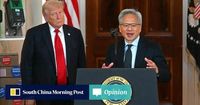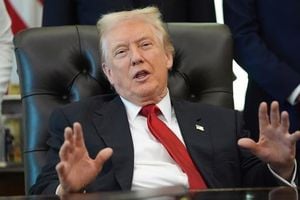China’s economic engine, once the envy of the world, is sputtering. The latest data from July 2025 paints a sobering picture: across production, consumption, and investment, the world’s second-largest economy is slowing sharply. This broad-based deceleration, reported by multiple outlets including Bloomberg and The Telegraph, suggests that China’s much-vaunted immunity to the ongoing trade war with the United States may be ending sooner than policymakers had hoped.
For months, Beijing has projected confidence that its economic fundamentals could weather any storm. But July’s numbers tell a different story. According to China’s National Bureau of Statistics, retail sales growth dropped from 4.8% in June to just 3.7% in July—well below the 4.6% analysts were expecting. Factory output growth, meanwhile, slumped to an eight-month low, with industrial output rising only 5.7% compared to 6.8% the previous month. Investment in factory equipment grew a mere 1.6% in the first seven months of the year, falling short of the anticipated 2.7% increase. New home prices, a key measure of household wealth, fell by 2.8% in July from a year earlier, following a 3.2% drop in June.
“China’s latest economic numbers are likely to ring alarm bells in policymaking circles,” Allianz economist Mohamed El-Erian told The Telegraph. ING economist Lynn Song added, “The accelerating downturn in property prices in the past few months signals that further policy support is needed. It’s difficult to expect consumers to spend with greater confidence if their biggest asset continues to decline in value every month.”
Compounding these woes, China’s industrial sector is being battered by more than just tariffs. Extreme weather—record-breaking heat, storms, and floods—has disrupted factory production and business operations across the country, according to the National Bureau of Statistics. These disruptions come as the government’s own efforts to stimulate growth, largely front-loaded to the early months of 2025, are losing their punch. Xu Tianchen of the Economist Intelligence Unit noted, “The economy is quite reliant on government support, and the issue is those efforts were ‘front-loaded’ to the early months of 2025, and by now their impact has somewhat faded out.”
But perhaps the most significant factor behind China’s slowdown is the intensifying trade war with the United States. Since President Donald Trump launched a new wave of tariffs and export controls, the global economic landscape has shifted dramatically. Tariffs on Chinese goods now exceed 100% in some cases, and a temporary trade truce agreed in May has only partially stemmed the uncertainty—its extension until November has not calmed jittery markets or consumers.
“China’s economy clocked its deepest slowdown of the year in July, raising expectations for Beijing to roll out more stimulus this year to offset the impact of Donald Trump’s trade war,” Bloomberg reported. Fixed-asset investment fell the most since the early days of the Covid-19 pandemic, and industrial activity growth was the weakest in eight months. The front-loading of factory production, an attempt to get ahead of US tariffs exceeding 50%, is now waning, leaving the sector exposed.
The trade war’s impact stretches far beyond China. US and Taiwan chip giants like Nvidia and AMD are caught in the crossfire. According to South China Morning Post, both companies will be exempted from certain US export restrictions to China—but only after agreeing to hand over 15% of any future sales to the US government. This move, which some legal scholars argue runs afoul of the US Constitution’s Export Clause, is emblematic of the Trump administration’s approach: tariffs and export controls serve not just to protect national security, but also to generate revenue for the US Treasury.
“Trump’s tariffs are part of a broader MAGA economic strategy beyond just trade deficits,” wrote The Edge Malaysia. A minimum 10% tariff is now imposed on countries with which the US has a trade surplus, and tariffs are applied broadly across all goods—not just targeted industries. In July alone, the US government collected nearly US$30 billion in tariff revenue, and US$152 billion so far in 2025. New trade deals that took effect on August 7 have pushed the effective tariff rate to around 18%, up from just 2% before Trump’s presidency. US Treasury Secretary Scott Bessent estimates tariff revenue will exceed US$300 billion this year and US$600 billion in 2026.
The ramifications are global. Trade deals struck by the US include commitments from the European Union to purchase US$750 billion in American energy products over three years and invest US$600 billion in the US economy. South Korea has pledged US$350 billion in investment, Japan US$550 billion, and Malaysia has agreed to US$150 billion in purchases and US$70 billion in investments over the coming years. To avoid tariffs, tech giants like Apple have ramped up US investments to US$600 billion over four years, Nvidia has pledged US$500 billion, and TSMC is investing US$165 billion in US plants.
For China, the picture is complicated. The country’s reliance on government spending to fuel growth is becoming increasingly apparent, but the political appetite for further fiscal stimulus appears to be waning. “We see little reason to expect much of an economic recovery during the rest of this year,” Zichun Huang of Capital Economics told The Telegraph. “The lack of committing to any additional fiscal support in the latest Politburo meeting points to a fading fiscal tailwind.”
Meanwhile, the trade war’s ripple effects are being felt in other economies. India, for example, is bracing for US tariffs of 50% later this month. Prime Minister Narendra Modi has responded by calling for greater self-reliance, urging his nation to manufacture everything from fertilisers to jet engines and electric vehicle batteries. “Farmers, fishermen, cattle rearers are our top priorities,” Modi declared in his Independence Day address, signaling a shift towards homegrown production in the face of rising protectionism.
Back in the US, the debate over tariffs remains contentious. Most economists argue that tariffs are inherently inflationary, raising prices for American consumers and reducing choices. Some domestic manufacturers benefit from higher prices, but those reliant on imported components suffer from reduced competitiveness. The result, they say, is slower global growth and weaker demand for US firms. Yet, supporters of the Trump administration’s approach argue that tariffs are a necessary tool to address long-standing trade imbalances, encourage domestic investment, and generate revenue for government priorities such as tax cuts and infrastructure spending.
As the world’s two largest economies navigate this new era of economic brinkmanship, the stakes could hardly be higher. China’s slowdown is a wake-up call for policymakers everywhere: the trade war’s costs are real, and the global economy is more interconnected—and vulnerable—than ever. How both sides respond in the months ahead will shape the economic landscape for years to come.





